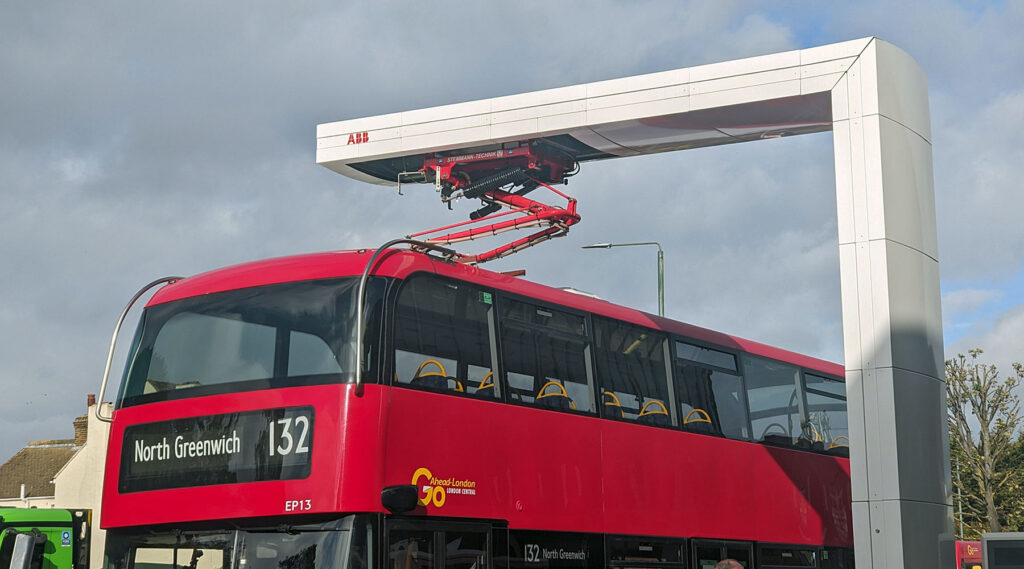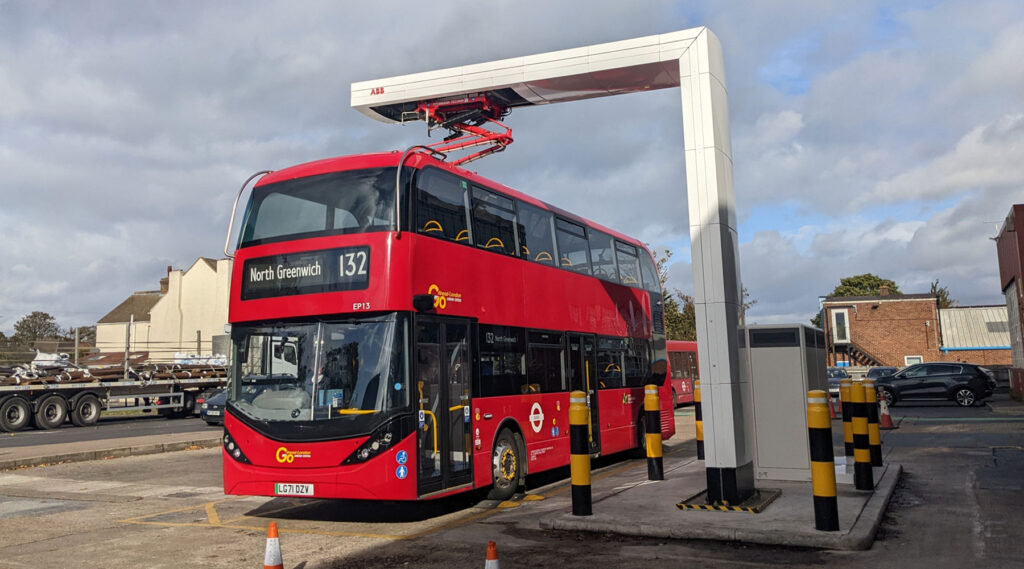A bus route in southeast London is testing an electric doubledecker bus that is thought to be the world’s first to use a reverse pantograph to top up the batteries.
Battery powered buses that are recharged overnight is not a new thing in London, and their use is spreading, but the experiment at Bexleyheath garage is testing a method of topping up the battery during the day. Topping up the battery during the day reduces the amount of charging needed overnight, and hence the number of buses needed to operate the service.
The reason for switching to electric power is that it eliminates road pollution at the point of use, and depending on how the electricity is generated, will reduce the reliance on fossil fuels to power London’s public transport.
Reducing road pollution is both something that’s good for London in general, but also locally very beneficial for people who live close to busy roads, which tends to be people at the lower end of the economic scale, who are therefore disproportionately affected by poor air quality. This was highlighted when I got a mouthful of fumes from a particularly dirty bus that was pulling out of a bus stop as I walked past on my way to see these new pollutionless buses being trialled.
There are currently 850 electric buses in London, which are usually charged overnight, but it can offer more flexibility if they could be topped up through the day, and if the buses can run further between charges, on some longer routes it would be possible to run the same service without needing to buy extra buses to fill gaps while buses are being recharged.
The experiment at Bexleyheath taps into what’s known as “opportunity charging”, where the bus drives pass the bus garage, and pops and stops at a charging point for a quick top-up.
Unlike old trolleybuses and modern trains, rather than putting the pantograph on top of the bus and raising it up to the charger, they’ve installed a reverse pantograph that drops down to the bus.
A 10-minute top-up can recharge the battery by about 20%, giving them around 20 miles more running time.
In use, it’s very simple – the bus drives up to the charging unit, and a couple of small bumps on the ground help the drivers park in the correct spot, then the driver has some switches on the bus to lower the pantograph for a top-up. The bus is disabled during charging to prevent accidental driving off, and when the bus is ready to start the next run along its route, the driver releases the pantograph and drives off.
Based on their existing bus timetable, each bus has roughly an hour of time during the day when the bus is idle between routes, and that gives them on average 6 opportunities each day to top-up the battery.
The fleet of buses being used on route 132 have been supplied by Alexander Dennis / BYD, and there’s 18 of their Enviro400 EV double-decker buses being used. The battery chassis comes from BYD, with the bus coach on top built by Alexander Dennis in the UK.
Go Ahead London, contracted to Transport for London, operates buses on route 132 and originally sought out the pantograph charging solution to deliver the battery top-ups. Suffolk-based EO Charging installed the charging infrastructure at the Bexleyheath bus garage.
Although single-decker buses with reverse pantographs are in use in many cities, this is thought to be the first trial using double-decker buses.
Louise Cheeseman, TfL’s Director of Bus, said: “The threats of toxic air, climate change and congestion are becoming clearer every day, and it’s vital that we find technical solutions that help us run clean, green services that get Londoners where they need to be. When buses can travel further each day, as they do with this exciting pantograph technology, we can deliver the same service that Londoners rely on without increasing the number of buses and invest in other routes.”
There’s more coming soon
One of London’s longest bus routes, also in South London, will soon start testing two pantograph chargers at either end of their long route, between Crystal Palace and Orpington.
A brand new fleet of 20 ieTram buses is being supplied by Spanish bus and coach maker, Irizar, with the first due to arrive in the UK next week, and the intention is that their batteries will be topped-up at either end of the bus route.
A standard garage charge alone would not sustain a zero-emission bus the entire day. Due to the length of the route, a pantograph at each end of the route, rather than back at the garage, will mean buses receive a quick boost on the spot. With minimal turnaround time, fewer buses can again provide the same level of service.
The 15-mile bus route 358 is currently served by a fleet of single-deck diesel buses but will see the electric buses introduced early next year once they have all arrived from Spain.
This article was published on ianVisits
SUPPORT THIS WEBSITE
This website has been running now for just over a decade, and while advertising revenue contributes to funding the website, but doesn’t cover the costs. That is why I have set up a facility with DonorBox where you can contribute to the costs of the website and time invested in writing and research for the news articles.
It’s very similar to the way The Guardian and many smaller websites are now seeking to generate an income in the face of rising costs and declining advertising.
Whether its a one-off donation or a regular giver, every additional support goes a long way to covering the running costs of this website, and keeping you regularly topped up doses of Londony news and facts.
If you like what your read on here, then please support the website here.
Thank you
The post Pantograph charged electric buses being tested in Southeast London appeared first on ianVisits.





